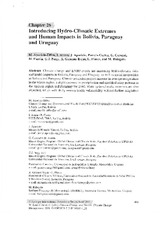Introducing hydro-climatic extremes and human impacts in Bolivia, Paraguay and Uruguay
Fecha
2016Autor
Aparicio-Effen, Marilyn
Arana, Ivar
Aparicio, James
Cortez, Pamela
Coronel, G
Pastén, M
Nagy, GJ
Rojas, Galeano
Flores, L
Bidegain, M
Metadatos
Mostrar el registro completo del ítemResumen
Abstract.
Climate change and ENSO events are increasing hydro-climatic risks and health impacts in Bolivia, Paraguay and Uruguay, as well as social inequalities in Bolivia and Paraguay. Climate scenarios project increase in average temperature in the whole region, a slight decrease in precipitation and modified rainy patterns in the Andean region and Paraguay for 2040. More hydro-climatic extremes are also expected, which will worsen health vulnerability without further adaptation measures. A Vulnerability, Impact and Adaptation Network conducted research on excessive rainfall, floods and land-slides from 2007 to 2014 in Bolivia, Paraguay and Uruguay. Herein, a case study of the vulnerability and human impacts of an extreme rainfall and land-slide in Callapa, La Paz, Bolivia in 2011 is presented. As result of early warning system (EWS) and emergency systems human life losses were not recorded. A comparison between two districts (with and without land-slide) was made modifying Urban HEART equity instrument. Its goal was to better inform the adaptation and community resilience measurements design. The health outcomes included dehydration, diarrhea, acute respiratory infections, and mental health issues. Inter-sectoral policies and strategies were developed to improve climate adaptation measures. Despite strong differences in socio-economic and health status the three studies countries are vulnerable to hydro-climatic extremes. EWS and preparedness based on climate and socio-economic assessments and monitoring are crucial to increase resilience to extreme events.

